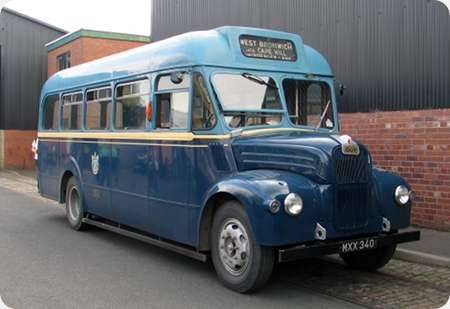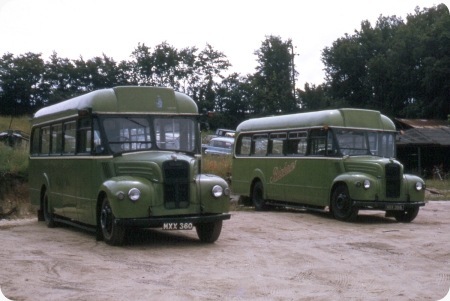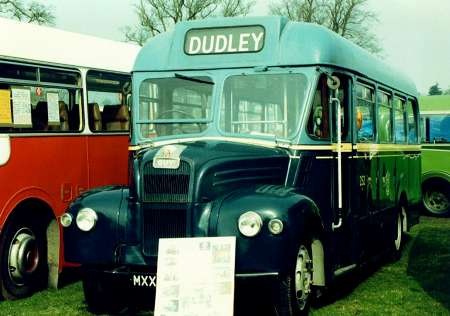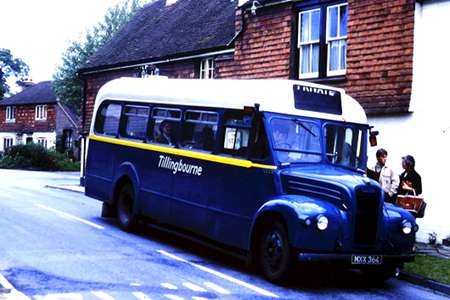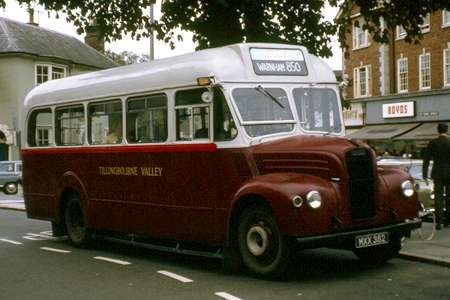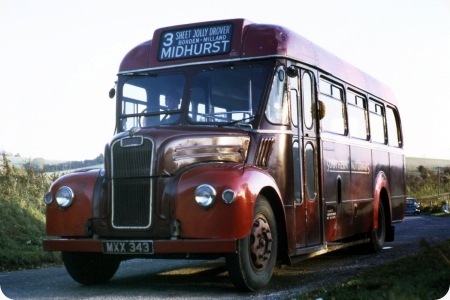
Copyright Roger Cox
Southern Motorways
1953
Guy GS
ECW B26F
Here is a picture of one of the ex LTE GS type Guy Specials operated by Basil Williams of Emsworth during the 1970s, who then traded as "Southern Motorways". In the week I "drove" a desk at London Country back then, and, to keep my hand in, I used to do a spot of driving for independents at weekends. One of these was North Downs Rural Transport, which, having taken over the business of A. T. Brady (T/A Brown Motor Services), was then based at Forest Green, Surrey. In March 1972, circumstances left North Downs with a vehicle shortage, and arrangements were made with Basil Williams to hire one of his GS buses. I travelled down to Emsworth on a Saturday with a colleague to collect the vehicle, and we were both less than impressed when the bus we were given, GS 43, MXX 343, was started up. The density of the exhaust smoke would have done credit to a Pre Dreadnought at Jutland, and, even allowing for the fact that the Perkins P6 always sounded like a bucket full of nails being shaken about, the racket from the engine was deafening. We expressed our disquietude to Mr Williams, and I remember his response to this day – "If anyone says that it’s knocking, then you can tell them that it’s just had its Annual". We set off back to Surrey in the thing, travelling hopefully rather than expecting to arrive, but our minimal optimism evaporated with each passing mile. The bus struggled painfully and overheated repeatedly up the merest of gradients, and it was on one of the recuperative rests to allow it to cool down that I took this picture. Such was the noise of the vehicle when in motion that even ancient rustics spotted walking far in front of us in the distance, whose hearing faculties must surely have diminished over the years, swung round in alarm on our approach. Eventually, after an interminable journey, we arrived back at Forest Green, and I thankfully left for my home at Farnborough. I subsequently learned that, when despatched on service on the following Monday, the GS failed totally less than a mile from the North Downs Depot. By this time, all patience had been lost, and Basil Williams was told in succinct terms to come and collect the vehicle
There is so much to tell about Mr Williams and his Hants and Sussex ventures, but I will leave that till later.
Photograph and Copy contributed by Roger Cox
22/09/11 – 06:17
At least he provided a rather nice comprehensive destination blind!
Chris Barker
22/09/11 – 14:02
Ref. the destination blind – yes, I’ve always thought that they seem very bespoke and comprehensive for a country independent. Did they get LT to make them as part of their purchase deal? Also, I’ve got a photo of a GS in Midhurst showing route 21. Did they have a large network or did they route share with Southdown/Aldershot & District?
Paul Haywood
23/09/11 – 06:23
I very much doubt that LTE made up the blinds for the Basil Williams fleet. From its inception, relations between Hants and Sussex and the surrounding major operators – Southdown, Aldershot and Distriot and London Transport – were forever fraught with deep suspicion, and no route sharing would ever have been considered. It was not until the Fowler Act that liberalised Road Service Licensing that Basil Williams was really able to operate free of constant Traffic Court battles with his neighbours. This legislation was beneficial to the industry, which hitherto was fettered by the absurdity of proving need for a service. (The subsequent ridiculous Ridley deregulation Act of 1985 was devised purely to flog off NBC and local authority public transport operations as quickly as possible, and private interest was stimulated by tearing up entirely all the public service obligations placed upon an operator by earlier legislation. Nowadays, operators can run what they like, when they like, and charge what they like for it.)
Route 21 ran Midhurst-Heyshott-Ambersham- Selham-Graffham-Petworth, but it underwent several changes throughout its existence. The best book by far on the extremely complicated Hants and Sussex saga is the one by Alan Lambert, and it is worth trying to get a copy. I have seen copies advertised on Amazon and Ebay.
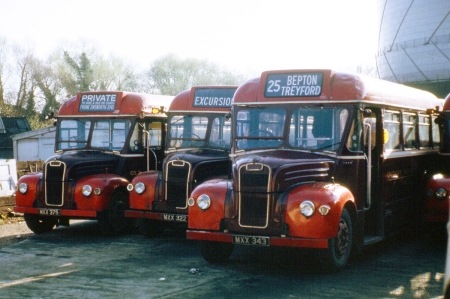
Above is a photo taken in the Emsworth depot on the same day that we collected GS 43. Unfortunately, the yard was deeply in shade, and I have had to "Photoshop" the picture rather heavily to make it usable. From the left may be seen GS 75 MXX 375, GS 22 MXX 322 and GS 43 MXX 343, plus another off camera to the right. It is interesting to note that 22 and 75 were withdrawn before 43, which lasted until 1974, which makes one wonder what state they were in.
Roger Cox
23/09/11 – 17:37
Fascinating, Roger – many thanks. I will certainly try to get a copy of the Hants & Sussex book as they sound to have been a really maverick outfit. However, I’m still intrigued by the high route numbers. Did they really have up to 25 routes?
Paul Haywood
24/09/11 – 07:20
Paul, over the entire lives of the Basil Williams/Hants and Sussex companies, the route numbers went up to the remarkable figure of 51, with some gaps in the sequence, but these were offset by some "A" and "B" suffixes. During WW2, in 1943, a certain Cecil Walling T/A Silver Queen Bus Service agreed to sell his business to Basil Williams. Mr Williams formed a new limited liability company called Silver Queen Motor Services Ltd. and applied, entirely reasonably, for the permit (Defence Permits replaced Road Service Licences during the war) to be transferred from Mr. Walling to his new company. Southdown objected to the transfer, and this objection was upheld, leaving Mr Williams with a new company without any business. The proposed purchase did not then proceed, and Mr Walling retained his permit until he sold out to Southdown at the end of that year. Basil Williams never forgot this episode, and in all his subsequent takeovers of other businesses he formed limited liability companies using the same company names and with the same directors, to whom all the RSLs were transferred without trouble, and then he replaced the old directors with himself and others within his empire. Thus grew the perplexing multiplicity of company names within the Hants and Sussex setup:
Hants and Sussex; Liss and District: Southsea Royal Blue; Empress Coaches Stockbridge; Triumph Coaches Southsea; Blakes Tours of Plymouth; Glider & Blue; Glider Coaches; B.S. Williams Ltd; White Heather Travel; Sunbeam Coaches Loxwood; F.H. Kilner; Southern Motorways.
Alan Lambert’s book unravels this labyrinthine tale in a masterly fashion, and is a masterpiece of its kind.
Roger Cox
24/09/11 – 11:35
Wow! I’ve just found a copy on Amazon and bought it. Many thanks for lifting the lid sufficiently for me to delve further.
Paul Haywood
25/09/11 – 07:14
Having read my copy of Alan Lambert’s ‘Hants & Dorset’ book again, I’m amazed at the bureaucracy involved with so many parties to do with route applications/transfers, increases/reductions in fares/service frequency, etc and how so much of it was tied up with petty squabbling and so little with giving good customer service. We may not be entirely happy with de-regulation, but it seems, in many ways, a better system.
Chris Hebbron
25/09/11 – 20:39
That is absolutely right ChrisH, permission had to be sought for even the most insignificant alterations, such as to change the starting point of an excursion. All these applications were then published in ‘Notices and Proceedings’ issued by the Traffic Commissioners either weekly or fortnightly, I cannot remember which, to allow any possible objections. Excursions, Tours and Express services had to be licensed in each traffic area they traversed even if they were just passing through! Most of the larger companies had specially printed ‘Notice of Objection’ forms stating their reasons and typically these would be;
1) The application would abstract traffic from existing facilities provided by ourselves
2) The application would cause unnecessary and wasteful competition
3) The application is unnecessary and undesirable in the public interest
4) Generally as may be adduced from evidence given at any public hearing held in connection with the application.
Number 3 particularly, I think is quite unbelievable but it was common practice for the larger operators to see themselves as judge of what was best for the passenger and very often this amounted to preventing people from travelling! Even the railways could object and often this resulted in a limitation on the number of vehicles which could be operated, regardless of demand. In whose interest the Traffic Commissioners operated is a matter of debate but it was by no means necessarily the travelling public!
Chris Barker
27/09/11 – 06:41
I see that three of this batch ended up in Travellers hands with predictable results..all destroyed! They are MXX 373,354 and 350. You can see pictures of their fading years here…. //www.travellerhomes.co.uk/?p=9231
From the comments above, maybe they were not missed!
Richard Leaman
27/09/11 – 06:45
For about ten years, I handled almost all the Traffic Court work for London Country, which included acting as advocate for the company at Traffic Commissioners’ Hearings (colloquially known as Traffic Court). Many operators believed that legal representation was required to pursue a case before the Traffic Commissioners – surprisingly, even Geoffrey Hilditch seems to have held this misapprehension. I am not a lawyer, and the only occasions upon which legal representation was employed were joint applications or objections with other operators, and applications for fares increases (which consisted of putting forward loads of statistical and financial bumph proving a need for increased revenue). On all other applications/objections submitted by the company, I was the representative for the company, and usually found myself contesting with solicitors or barristers acting for opposing parties. I won far more cases than I lost, because the main factor was a knowledge of the bus industry and the relevant legislation (mainly the Road Traffic Act 1930, much of which still applied, and the Transport Act 1968). Lawyers, including QCs, didn’t have that knowledge, and their painful ignorance of the subject frequently became clear when arraigned before the Commissioner. Having said all this, I, too, believed that the legislation and procedure was absurdly outdated and loaded in favour of big operators. This was remedied by Norman Fowler’s Transport Act 1980 which deregulated coach services and changed the emphasis of Road Service Licensing in favour of applicants. This made the old practice of blocking competition by objection a thing of the past, but still laid public service obligations upon operators. This was assuredly in the interests of the public. Ridley’s 1985 Act was designed solely to destroy public ownership by privatising NBC and local authority undertakings, invariably at a fraction of the true value. Ridley’s knowledge of the industry could have been written on the back of a postage stamp, underneath the Lord’s Prayer, and he couldn’t have cared less. Total deregulation did not meet the needs of the travelling public, and left us with the overpriced monopolistic shambles that afflicts us today.
Roger Cox
27/09/11 – 11:15
That’s telling it as it is, Roger – but I do agree.
David Oldfield
11/05/13 – 08:59
I have a photo (provided by someone from Reading) of an open charabanc (possibly mid-late 1930s) with the words Silver Queen painted just below the windscreen. Someone has mentioned that there was a company called Cox’s Silver Coaches in Northumberland Avenue, Reading, Berkshire in existence at about that time. Would anyone know if there is a link between the charabanc and the company and if Roger Cox – a contributor to this website – is a descendent of the company?
Jim B-P
11/05/13 – 12:10
Thx, Chris B and Roger, for your comments, which passed me by until now – must’ve been away for a few days. You inner experiences are very interesting and it is definitely a pity that Norman Fowler’s ‘middle way’ didn’t remain. Your comments certainly show up the self-serving nature of the 1930 Act, especially point 3 of the Notice of Objection forms. Of course, the public was quite unaware of what was going on behind virtually closed doors.
Chris Hebbron
11/05/13 – 18:01
I have to disappoint Jim B-P, I’m afraid. I have no familial connections with the Reading area. Continuing the discussion about the 1985 Ridley Act, the big groups are now driven entirely by a lust for huge profit margins to satisfy the City. The primary objective is that of keeping the share price as high as possible. Locally, Stagecoach has left significant communities in Cambridgeshire with limited service or none at all in its pursuit of big margins. Two years ago, the Stagecoach group returned £340 million to its shareholders, with Brian Souter himself taking £51 million, and his sister, Ann Gloag, £37 million, yet the fares increases continue to pile in year upon year. Making a reasonable return is no longer the name of the game for the heavyweights, and the concept of public service has become a joke. Thankfully, some smaller operators still show how it can and should be done. Around here we have Delaine and Norfolk Green, both of whom have stepped in – Delaine in Market Deeping and Norfolk Green in Kings Lynn – where the avaricious national groups have given up their pursuit of their (many) pounds of flesh.
Roger Cox
12/05/13 – 06:58
So, Basil Williams: valiant entrepreneur battling the "big boys" in the interests of the travelling public, or under-capitalised and over-extended and out to make a name/empire for himself – what’s the verdict? To me, there seem to be a lot of parallels between Basil Williams and Julian Peddle: over the span of 20+ years I’ve experienced Julian Peddle’s operations in Burton-upon-Trent, Colchester, and Milton Keynes, and I can’t say I was impressed. It would seem to me – both from the pictures of the GSs (nicely turned out, nice livery, good destination blinds), and from Alan Lambert’s book – that Basil Williams tried to present a "big company" image (Hants & Sussex) without ever having had the resources to back it up. Some small independents did manage to do that quite successfully: off the top of my head – West Wales, South Notts, South Yorkshire, Birch (?) . . . Gosport & Fareham/Provincial was I think the last remaining passenger carrying company of a larger group that had diversified, and Jones (Aberbeeg) and Moores (Kelvedon), whilst substantial concerns, were clearly (and defiantly?) independent.
Philip Rushworth
12/05/13 – 09:30
Ah, Julian Peddle. He adopts the technique of a wholesale business in the bus industry, buying up companies for short periods of operation and then selling them on. Huntingdon can be added to Philip’s list of Mr Peddle’s "successes", and he is still buying up under the Centrebus banner. Locally, Kimes has now fallen into his clutches, and it shows. I agree that there are some parallels with Basil Williams, but, for all its undoubted faults, the old Road Service Licensing system did act as a brake upon the activities of the less dependable elements in the industry. We now have a complete free for all, with no controls whatsoever upon any buccaneers in the business. Also, unlike the rail, air and holiday industries, the bus passenger now has no protective legislation over fares and services whatsoever.
Roger Cox
13/05/13 – 07:38
I’m in complete agreement with Roger’s comments about the profiteering of the big groups. I was in Torquay at the weekend and when I left there wasn’t a convenient train up the branch to Newton Abbot so I thought I’d take the bus instead. Stagecoach, quite well presented I do admit but when I asked for a single ticket I was staggered to be charged £3.70 for a journey of less than thirty minutes! It appears to be the norm now though, TrentBarton, still technically a private concern, have become one of the most expensive bus companies in England. The tenet seems to be; we provide something akin to a taxi service, let’s charge something akin to taxi fares!
Chris Barker
14/05/13 – 11:54
Chris, I had to make an early morning journey from my village to Biggleswade last week. The vaunted "Busway" vehicle from Peterborough turned up ten minutes late and cost me £3.70 for the nine mile trip to Huntingdon. The punctual train from there to Biggleswade, some 18 miles, cost £5.90. The bus charges 39p per mile (7/10d in real money) whereas the train costs 33p per mile (6/7d). Bring back road service licensing!
Roger Cox
14/05/13 – 17:24
Come and live in Edinburgh where Lothian charge £1-50 any distance and the natives still think they are getting a raw deal!!!.
Philip Carlton
06/01/14 – 07:52
Were any of the GS type ever painted red or was there any planned use in the central area for them?
Colin Rutter
06/01/14 – 17:05
It’s reputed, Colin, that one was painted red, but never went into service. There were a couple of proposals to put them on Central Area routes, but this came to naught.
The excellent Ian’s Bus Stop website has the whole story. SEE:- www.countrybus.org/GS/GS.html
Chris Hebbron
07/01/14 – 07:02
The GS fleet of 84 vehicles was way above the actual LT Country Bus requirement in 1953 for OMO (as it then was) buses. At that time one person operated buses were restricted in law to a maximum of 20 passengers, but Traffic Commissioners were empowered to increase this limit to 26 passengers at their discretion, and the GS fleet was so configured. It was rumoured that some of the GS buses were originally intended to form the rolling stock for a reintroduced London "Inter Station" facility that had originally been run by the pre war forward control half decker Leyland Cubs, but this proposal was abandoned. Whatever the truth may have been, in the event, LT had more GS buses than it ever needed.
Roger Cox
07/01/14 – 08:44
I accept that this is purely a personal opinion, but I have always thought that the GS class vehicles were the most handsome and well proportioned buses of all the normal control "little buses" that we’ve known. The secret may possibly lie largely in the combination of the proprietary bonnet/wing assembly and the inevitably delightful ECW bodywork. Despite all this glowing admiration I’ve unfortunately never ridden on a GS !!
Chris Youhill
07/01/14 – 13:34
Oh they’re cuddly and loveable little beasts, with their clatterly, chattery Perkins engines and Chinese gearboxes – and you must put a ride on your to do list, Chris. The Mercedes-Benz Vario is the nearest modern bus but doesn’t begin to compare on character and long-lived quality.
David Oldfield
07/01/14 – 13:35
I agree with you, Chris Y, but it’s clear that LT had a lot of input into the vehicle to get it to the standard they wanted. A&D’s Dennis Falcon/Strachans, were also quite attractive, perhaps greatly aided by the livery. However, the couple of journeys I took on them indicated that they were not so refined as the GS, especially in the ‘engine noise’ department!
Chris Hebbron
08/01/14 – 07:35
They were certainly popular little buses.
The existence of so many survivors into preservation confirms their attraction – and comparative ease in restoring and saving them.
I have heard it said on the rally circuit that there were only 84 GS’s built, but there are 106 preserved !
Petras409
02/02/14 – 16:37
Philip Rushworth’s comments about H&S are interesting. I understand that one of the reasons for H&S failure was because Basil Williams was quite foresighted.! He believed that there would be a large demand for buses/coaches after the war ended and ordered quite large numbers of both from Leyland and Bedford. Unluckily for him, when they were delivered up till about 1951, the price of fuel and other factors meant that demand for travel began to drop, and he was left with a lot of new vehicles with insufficient work and he had difficulty balancing the books. One result of this was that new PD1s were hired to Cardiff Corporation for I think 1 year, and many coaches were sold after a short life with H&S. H&S also suffered from the licencing system as follows: One of H&S’s companies was Triumph Coaches who successfully applied for Forces weekend leave services licences to the North of England and Plymouth. A number of Portsmouth operators ran coaches to similar destinations in competition with Triumph, without licences as ‘private hire’ including surprisingly Southdown, who did have some licences including London.
Paul Statham
06/02/14 – 16:19
I have owned GS42 since December 1973. It was the last one in service in March 72 on Route 336A. It was sold to Matthew Arnold School, Staines where I bought it. I have rallied it every year since then. I don’t know how many miles I’ve covered in it as like other LT buses of the day it doesn’t have a mileometer, but it’s never let me down (Touch Wood). Yes the engine is a bit chattery but very reliable. It always starts after sitting for a week or so without any assistance, glow plugs or easy start. The bodies are very robust with aluminium panels and frame. Very little wood and just the front bonnet and wings in steel. Rust in those parts can be a problem. Based in Surrey I’ve rallied it in Wales and Scotland and many places in between. 42mph and 18-20 mpg.
Slow but economical.
Geoff Heels
07/02/14 – 06:30
It must be a relief you never bought it from Basil Williams, Geoff!
I can recall visiting an aunt, with my mother, around 1955. She lived at Gomshall and we took a GS on the 448(?) from Guildford to get there and back. I was impressed, but disappointed it never went straight up the steep High Street!
It’s surprising that Perkins are still going vey strong internationally, albeit with an industrial bent nowadays.
Chris Hebbron
07/02/14 – 06:31
Didn’t Southdown take over Triumph in the early 60’s and continue to use their livery on some coaches?
Paragon
18/05/15 – 06:50
I have been a GS enthusiast from more or less since these great little vehicles replaced the Cubs on my local route (490) in 1953.
I knew most of our regular Drivers, most of whom put me off outside my front door after Primary School ended for the day. They were The Gentlemen at NF. I got on one morning after I had gone on to senior school, and Sid the driver said "Shut the door please!" The electrics were having an off day! Most of our Driver preferred a GS over an RF as they could tuck the GS in completely in driveways en route whereas it was nose or tail with an RF! Great Days. I wish we could go back to them!
Mr Anon
19/05/15 – 06:08
Ah, Yes, that personal touch. Very rare nowadays!
Chris Hebbron
20/05/15 – 05:53
Paragon is right in saying that Southdown took over Triumph Coaches. They had a separate livery (Blue and Cream)but I don’t know whether a separate subsidiary company was set up or not. The Southdown Enthusiasts’ Club issues many publications and no doubt would have one providing the detail.
Andy Hemming
20/05/15 – 05:54
The personal touch isn’t quite dead. Our next door neighbour drives for a small local company that runs half a dozen rural bus services. He sometimes brings a bus home to wash it! Yesterday, my wife set off in the rain to go to town. The bus stop second from the terminus is a couple of hundred yards away. Neighbour was outside his house, washing a bus as usual. My wife saw this bus turn out of our road, head off to the terminus, then come back a couple of minutes later. When she got on the neighbour said, "Why on earth didn’t you just get on at home?" I am sure this is "strengst verboten" – and hence no clues as to names or location!
Stephen Ford
 Vehicle reminder shot for this posting
Vehicle reminder shot for this posting
24/12/15 – 06:20
I would reiterate what Roger Cox said. While some licensing control for stage carriage services is obviously necessary to preserve the network ( which is one reason that today the network is not preserved ), the excursion and tour licensing was over regulated and stifled innovation and traffic generation.
The situation where a major operator could object to an excursion destination( and restricting linking licences for destinations of limited appeal), even when that operator patently had no intention of offering that destination is reminiscent of the Keystone Cops. The lost opportunities for both operators and the travelling public must be legion.
Malcolm Hirst
24/12/15 – 11:48
I’ve been having another look at this thread, prompted by Malcolm’s comment of 24 December 2015, published at 06.20, and I refer to Chris Barker’s thoughts (13 May 2013) about taxi fares.
In one meeting of a Committee of Southampton City Council, my then Manager reported to the team that a Councillor [who was a taxi driver] commented that a Southampton taxi was, mile for mile, more expensive than crossing the Atlantic by Concorde. Now, there’s a thought.
Pete Davies
25/12/15 – 07:57
Pete, on the subject of cost per mile. Wallsend to Newcastle, 3 miles £2-35p = 78p Per mile. Newcastle to Jedburgh, 57 miles £6-10p = 10.7p Per mile
Ronnie Hoye
